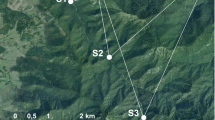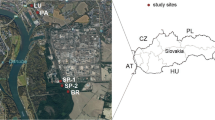Abstract
Harvestmen have a general distribution pattern with more species and higher abundance in forests than in open habitats, as previously verified in mountain Cantabrian areas of northern Spain, of the Orocantabrian Province. The study of harvestmen of the low Cantabrian areas of the adjacent biogeographic Cantabro-Atlantic Province is highly appropriate to determine the influence of biogeographic position on the main diversity parameters and the effect of different land uses on harvestman assemblages. The main types of managed habitats (forest plantations and secondary grasslands), together with natural forests, non-planted young forests, shrublands and habitat boundaries were continuously sampled with seven pitfall traps during 1 year at 28 sites. The harvestman assemblages were classified using six different analyses, and indicator species were identified. The spatial patterns of harvestman diversity in low areas differed from those of mountain areas, although they have 15 species in common. Remarkably, higher average harvestman species richness was measured in low Cantabrian areas than in mountain areas. Shrublands and boundaries were the most species-rich habitats. Forested areas were the poorest in abundance, and were not the habitats richest in harvestman species, though they had higher average richness than mountain Cantabrian forests. Grasslands had a unique harvestman composition with significant extraordinary abundances, in particular of Homalenotus quadridentatus (indicator species of this habitat) and H. laranderas. Interestingly, H. laranderas, Paroligolophus agrestis and Ischyropsalis hispanica, indicator species of some open habitats in low Cantabrian areas, have recently been shown to be indicators of shady forests in mountain Cantabrian territories.




Similar content being viewed by others
References
Clarke KR, Gorley RN (2006) PRIMER v6: user manual/tutorial. PRIMER-E Ltd, Plymouth
Curtis DJ, Machado G (2007) Ecology. In: Pinto-da-Rocha R, Machado G, Giribet G (eds) Harvestmen. The biology of opiliones. Harvard University Press, Cambridge, pp 280–308
De Cáceres M, Jansen F (2014) Studying the statistical relationship between species and groups of sites. Indicspecies-package 1.7.32014-07-10. GPL
De Cáceres M, Legendre P (2009) Associations between species and groups of sites: indices and statistical inference. Ecology 90(12):3566–3574
Dengler J, Janišová M, Török P, Wellstein C (2014) Biodiversity of palaearctic grasslands: a synthesis. Agr Ecosyst Environ 182:1–14
Dennis P, Young MR, Bentley C (2001) The effects of varied grazing management on epigeal spiders, harvestmen and pseudoscorpions of Nardus stricta grassland in upland Scotland. Agr Ecosyst Environ 86:39–57
Díaz González TE, Fernández Prieto JA (1994) La vegetación de Asturias. Itinera Geobot 8:243–528. Servicio de Publicaciones de la Universidad de León, León
Duelli P, Studer M, Marchand I, Jakob S (1990) Population-movements of arthropods between natural and cultivated areas. Biol Conserv 54(3):193–207
Dufrêne M, Legendre P (1997) Species assemblages and indicator species: the need for a flexible assymmetrical aproach. Ecol Monogr 67(3):345–366
García Manteca P, Valderrábano Luque J, Álvarez García MA (2005) Cartografía y tipificación de los pastos de Asturias. In: De la Roza B, Martínez A, Carballal A (eds) Producciones agroganaderas: Gestión eficiente y conservación del medio natural, vol II. XLV Reunión Científica de la SEEP, SERIDA, Gijón, pp 731–737
Hammer Ø, Harper DAT, Ryan PD (2001) PAST: paleontological statistics software package for education and data analysis. Palaeontol Electron 4(1):9. http://palaeo-electronica.org/2001_1/past/issue1_01.ht
Hicks BJ, McKenzie F, Cosens D, Watt AD (2003) Harvestman abundance and diversity within lodgepole and Scots pine plantations of Scotland and their impact on pine beauty moth populations. For Ecol Manage 182:355–361
Hill MO (1973) Diversity and evenness: a unifying notation and its consequences. Ecology 54(2):427–432
Hortal J, Lobo JM (2005) An ED-based protocol for optimal sampling of biodiversity. Biodivers Conserv 14:2913–2947
Hortal J, García-Pereira P, García-Barros E (2004) Butterfly species richness in mainland Portugal: Predictive models of geographic distribution patterns. Ecography 27:68–82
Ivask M, Kuu A, Meriste M, Truu J, Truu M, Vaater V (2008) Invertebrate communities (Annelida and epigeic fauna) in three types of Estonian cultivated soils. Eur J Soil Biol 44:532–540
Jost L (2007) Partitioning diversity into independent alpha and beta components. Ecology 88:2427–2439
Klimeš L (1999) Harvestman assemblages (Arachnida: Opiliones) in Krkonose National Park. Klapalekiana 35:129–138
Komposch C, Gruber J (1999) Vertical distribution of harvestmen in the Eastern Alps (Arachnida: Opiliones). Bull Br Arachnol Soc 11(4):131–135
Ledoux JC, Emerit M (2006) Araignées et opilions de la réserve naturelle de Prats de Mollo (Pyrénées Orientales). Office pour les Insectes et leur environnement du Languedoc-Roussillon, Perpignan
Marasas ME, Sarandón SJ, Cichino AC (2001) Changes in soil arthropod functional group in a wheat crop under conventional and no tillage systems in Argentina. App Soil Ecol 18:61–68
Marshall EJP, Moonen AC (2002) Field margins in Northern Europe: their functions and interactions with agriculture. Agr Ecosyst Environ 89:5–21. https://doi.org/10.1016/S0167-8809(01)00315-2
Merino Sáinz I, Anadón A (2008) La fauna de Opiliones (Arachnida) de la Reserva Integral Natural de Muniellos (Asturias) y del Noroeste de la Península Ibérica. Boln SEA 43:199–210
Merino Sáinz I, Anadón A (2009) Primera cita del género Paramiopsalis Juberthie, 1962 (Arachnida: Opiliones, Sironidae) para Asturias (España). Boln SEA 45:556–558
Merino-Sáinz I, Anadón A (2013) La fauna de Opiliones (Arachnida) de Asturias y Cantabria (España): catálogos e importancia de las especies y de los endemismos. Rev Ibérica Aracnol 23:57–77
Merino-Sáinz I, Anadón A (2015) Local distribution patterns of harvestmen (Arachnida: Opiliones) in a Northern temperate Biosphere Reserve landscape: influence of orientation and soil richness. Belg J Zool 145(1):3–16
Merino-Sáinz I, Anadón A, Torralba-Burrial A (2013) Harvestmen of the BOS arthropod collection of the University of Oviedo (Spain) (Arachnida, Opiliones). ZooKeys 341:21–36. https://doi.org/10.3897/zookeys.341.6130
Morris MG (2000) The effects of structure and its dynamics on the ecology and conservation of arthropods in British grasslands. Biol Conserv 95:129–142
Paschetta M, La Morgia V, Masante D, Negro M, Rolando A, Isaia M (2013) Grazing history influences biodiversity: a case study on ground-dwelling arachnids (Arachnida: Araneae, Opiliones) in the Natural Park of Alpi Marittime (NW Italy). J Insect Conserv 17:339–356. https://doi.org/10.1007/s10841-012-9515-y
Peterken GF (1993) Woodland conservation and management. Chapman and Hall, London
Pfiffner L, Luka H (2000) Overwintering of arthropods in soils of arable fields and adjacent semi-natural habitats. Agr Ecosyst Environ 78:215–222
Prieto C (2003) Primera actualización de la Check-List de los Opiliones de la Península Ibérica e Islas Baleares. Rev Ibérica Aracnol Zaragoza 8(31-XII):125–141
R Development Core Team (2014) R: a language and environment for statistical computing. “Sock it to Me” The R foundation for statistical computing platform: i386-w64-mingw32/i386 (32-bit). R Development Core Team, Vienna
Rambla M (1974) Consideraciones sobre la Biogeografía de los Opiliones de la Península Ibérica. Miscellanea Alcobé, Barcelona, pp 45–46
Rambla M (1985) Artrópodos epigeos del Macizo de San Juan de la Peña (Jaca, Huesca). Pirineos 124:87–169
Rambla M, Perera A (1989) Resultados de una primera campaña de prospección de los Opiliones (Arachnida) del Parque Nacional de Ordesa y Monte Perdido, vol 1. Lucas Mallada, Revista de Ciencias, pp 195–202
Rambla M, Perera A (1995) 2. Opiliones. Catalegs de flora: fauna. El Patromoni del Montseny, Diputacio de Barcelona, Servei de Parcs Naturals, pp 29–31
Rivas-Martínez S, Penas A, Díaz TE (2004) Bioclimatic and biogeographic maps of Europe. Cartographic Service, University of León, Spain
Rosa García R, Jáuregui BM, García U, Osoro K, Celaya R (2009a) Effects of livestock breed and grazing pressure on ground-dwelling arthropods in Cantabrian heathlands. Ecol Entomol 34:466–475
Rosa García R, Jáuregui BM, García U, Osoro K, Celaya R (2009b) Responses of arthropod fauna assemblages to goat grazing management in northern Spanish heathlands. Environ Entomol 38(4):985–995
Rosa García R, Ocharan FJ, García U, Osoro K, Celaya R (2010a) Ground-dwelling arthropod communities present in three types of Cantabrian (NW Spain) heath-land grazed by sheep or goats. Eur J Entomol 107:219–227
Rosa García R, Ocharan FJ, García U, Osoro K, Celaya R (2010b) Arthropod fauna on grassland-heathland associations under different grazing managements with domestic ruminants. CR Biol 333:226–234. https://doi.org/10.1016/j.crvi.2009.12.008
Stašiov S, Uhorskaiová L, Svitok M, Hazuchvá L, Vician V, Kočík K (2011) Influence of agricultural management form on the species structure of harvestman (Opiliones) communities. Biol Sect Zool 66(1):149–155. https://doi.org/10.2478/s11756-010-0139-y
StatSoft (2001) STATISTICA 6 (data analysis software system and computer program manual). StatSoft, Tulsa
Tuomisto H (2010) A consistent terminology for quantifying species diversity? Yes, it does exist. Oecologia 164:853–860
Zingerle V (1999) Epigäische Spinnen und Weberknechte im Naturpark Sextener Dolomiten und am Sellajoch (Südtirol, Italien) (Araneae, Opiliones). Ber Nat Med Ver Innsb 86:165–200
Acknowledgements
The Government of the Principado de Asturias provided the predoctoral Grant 2008-2011 (research scholarship of I. Merino), reference: BP08039, obtained through the “Severo Ochoa Program” of the FICYT Foundation. We thank Carlos Prieto for help in taxonomic and identification enquiries, T.E. Díaz-González and J.A. Fernández Prieto for help in habitat characterization, Mario O. Díaz Anadón for obtaining the species indicator values and Irene Fernández-Rodríguez and Florentino Braña for assistance in statistical analyses.
Author information
Authors and Affiliations
Corresponding author
Rights and permissions
About this article
Cite this article
Merino-Sáinz, I., Anadón, A. Land use influences harvestman diversity in northern Spain: a case study involving secondary grasslands and forest plantations (Arachnida: Opiliones). J Insect Conserv 22, 363–376 (2018). https://doi.org/10.1007/s10841-018-0066-8
Received:
Accepted:
Published:
Issue Date:
DOI: https://doi.org/10.1007/s10841-018-0066-8




